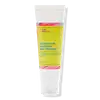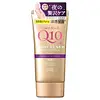What's inside
What's inside
 Key Ingredients
Key Ingredients

 Benefits
Benefits

 Concerns
Concerns

 Ingredients Side-by-side
Ingredients Side-by-side

Water
Skin ConditioningGlycerin
HumectantAspergillus Ferment
Skin ConditioningPropanediol
SolventCetearyl Alcohol
EmollientSaccharomyces Ferment
Skin ConditioningCetyl Tranexamate Mesylate
Skin ConditioningGlyceryl Stearate
EmollientNiacinamide
SmoothingBehentrimonium Methosulfate
Simmondsia Chinensis Seed Oil
EmollientPanthenol
Skin ConditioningPalmitic Acid
EmollientCaprylyl Glyceryl Ether
CleansingCapryloyl Salicylic Acid
ExfoliatingStearic Acid
CleansingArginine
MaskingCaprylhydroxamic Acid
Sodium Hydroxide
BufferingWater, Glycerin, Aspergillus Ferment, Propanediol, Cetearyl Alcohol, Saccharomyces Ferment, Cetyl Tranexamate Mesylate, Glyceryl Stearate, Niacinamide, Behentrimonium Methosulfate, Simmondsia Chinensis Seed Oil, Panthenol, Palmitic Acid, Caprylyl Glyceryl Ether, Capryloyl Salicylic Acid, Stearic Acid, Arginine, Caprylhydroxamic Acid, Sodium Hydroxide
Water
Skin ConditioningButylene Glycol
HumectantGlycerin
HumectantTriethylhexanoin
MaskingCetearyl Alcohol
EmollientDipropylene Glycol
HumectantBehenyl Alcohol
EmollientPetrolatum
EmollientParaffinum Liquidum
EmollientHydrogenated Rapeseed Glycerides
EmulsifyingLimnanthes Alba Seed Oil
Skin ConditioningPrunus Amygdalus Dulcis Oil
Skin ConditioningOlea Europaea Fruit Oil
MaskingGlycosyl Trehalose
Emulsion StabilisingTocopherol
AntioxidantPanthenol
Skin ConditioningSodium Hyaluronate
HumectantSimmondsia Chinensis Seed Oil
EmollientUbiquinone
AntioxidantHydrolyzed Collagen
EmollientDisodium EDTA
Acrylates/C10-30 Alkyl Acrylate Crosspolymer
Emulsion StabilisingCarrageenan
Agar
MaskingXanthan Gum
EmulsifyingDimethicone
EmollientSodium Methyl Stearoyl Taurate
CleansingSorbitan Palmitate
EmulsifyingStearic Acid
CleansingPolysorbate 80
EmulsifyingDiisostearyl Malate
EmollientHydrogenated Starch Hydrolysate
HumectantSodium Hydroxide
BufferingPhenoxyethanol
PreservativeMethylparaben
PreservativeParfum
MaskingCaramel
Cosmetic ColorantCI 77492
Cosmetic ColorantWater, Butylene Glycol, Glycerin, Triethylhexanoin, Cetearyl Alcohol, Dipropylene Glycol, Behenyl Alcohol, Petrolatum, Paraffinum Liquidum, Hydrogenated Rapeseed Glycerides, Limnanthes Alba Seed Oil, Prunus Amygdalus Dulcis Oil, Olea Europaea Fruit Oil, Glycosyl Trehalose, Tocopherol, Panthenol, Sodium Hyaluronate, Simmondsia Chinensis Seed Oil, Ubiquinone, Hydrolyzed Collagen, Disodium EDTA, Acrylates/C10-30 Alkyl Acrylate Crosspolymer, Carrageenan, Agar, Xanthan Gum, Dimethicone, Sodium Methyl Stearoyl Taurate, Sorbitan Palmitate, Stearic Acid, Polysorbate 80, Diisostearyl Malate, Hydrogenated Starch Hydrolysate, Sodium Hydroxide, Phenoxyethanol, Methylparaben, Parfum, Caramel, CI 77492
 Reviews
Reviews

Ingredients Explained
These ingredients are found in both products.
Ingredients higher up in an ingredient list are typically present in a larger amount.
Cetearyl alcohol is a mixture of two fatty alcohols: cetyl alcohol and stearyl alcohol. It is mainly used as an emulsifier. Emulsifiers help prevent the separation of oils and products. Due to its composition, it can also be used to thicken a product or help create foam.
Cetearyl alcohol is an emollient. Emollients help soothe and hydrate the skin by trapping moisture.
Studies show Cetearyl alcohol is non-toxic and non-irritating. The FDA allows products labeled "alcohol-free" to have fatty alcohols.
This ingredient is usually derived from plant oils such as palm, vegetable, or coconut oils. There is debate on whether this ingredient will cause acne.
Due to the fatty acid base, this ingredient may not be Malassezia folliculitis safe.
Learn more about Cetearyl AlcoholGlycerin is already naturally found in your skin. It helps moisturize and protect your skin.
A study from 2016 found glycerin to be more effective as a humectant than AHAs and hyaluronic acid.
As a humectant, it helps the skin stay hydrated by pulling moisture to your skin. The low molecular weight of glycerin allows it to pull moisture into the deeper layers of your skin.
Hydrated skin improves your skin barrier; Your skin barrier helps protect against irritants and bacteria.
Glycerin has also been found to have antimicrobial and antiviral properties. Due to these properties, glycerin is often used in wound and burn treatments.
In cosmetics, glycerin is usually derived from plants such as soybean or palm. However, it can also be sourced from animals, such as tallow or animal fat.
This ingredient is organic, colorless, odorless, and non-toxic.
Glycerin is the name for this ingredient in American English. British English uses Glycerol/Glycerine.
Learn more about GlycerinPanthenol is a common ingredient that helps hydrate and soothe the skin. It is found naturally in our skin and hair.
There are two forms of panthenol: D and L.
D-panthenol is also known as dexpanthenol. Most cosmetics use dexpanthenol or a mixture of D and L-panthenol.
Panthenol is famous due to its ability to go deeper into the skin's layers. Using this ingredient has numerous pros (and no cons):
Like hyaluronic acid, panthenol is a humectant. Humectants are able to bind and hold large amounts of water to keep skin hydrated.
This ingredient works well for wound healing. It works by increasing tissue in the wound and helps close open wounds.
Once oxidized, panthenol converts to pantothenic acid. Panthothenic acid is found in all living cells.
This ingredient is also referred to as pro-vitamin B5.
Learn more about PanthenolThis oil comes from the seeds of the desert shrub called Jojoba. It is more commonly known as jojoba oil, a non-comedogenic oil.
Jojoba oil does not contain fragrance and has many fatty-acids, making it a great soothing ingredient.
It also contains Vitamin E, a great moisturizing ingredient. Vitamin E is also an antioxidant and protects your skin against oxidative damage.
This ingredient humectant properties, meaning it helps draw moisture from the air. This helps keep your skin hydrated.
While jojoba has antibacterial properties, it is only able to kill some strains of bacteria.
Studies also show it helps in wound healing. In fact, Indigenous cultures have used jojoba as a moisturizer and to help treat burns for centuries.
Fun fact: Jojoba oil similar to natural human skin sebum, so it has a great effect on dry skin. It is also promising with helping to regulate sebum production.
Due to its fatty acid content, Jojoba oil may not be fungal acne safe. We recommend speaking with a professional if you have any concerns.
Learn more about Simmondsia Chinensis Seed OilSodium Hydroxide is also known as lye or caustic soda. It is used to adjust the pH of products; many ingredients require a specific pH to be effective.
In small amounts, sodium hydroxide is considered safe to use. However, large amounts may cause chemical burns due to its high alkaline.
Your skin has a natural pH and acid mantle. This acid mantle helps prevent harmful bacteria from breaking through. The acid mantle also helps keep your skin hydrated.
"Alkaline" refers to a high pH level. A low pH level would be considered acidic.
Learn more about Sodium HydroxideStearic Acid is a fatty acid. It is an emollient, emulsifier, and texture enhancer.
As an emollient, stearic acid helps soften skin. It aids the skin's protective barrier by preventing water loss. It also provides a gentle cleansing effect without stripping away natural oils.
Stearic acid may also be used to enhance the texture of products. It can add volume and stabilize ingredients such as water and oil. This can help water and oil ingredients from separating.
Sources of stearic acid include animal or vegetable fats/oils such as coconut or shea. It can be naturally found in butter, cocoa butter, shea butter, vegetable fats, and animal tallow.
This ingredient may not be Malassezia folliculitis, or fungal-acne safe.
Learn more about Stearic AcidWater. It's the most common cosmetic ingredient of all. You'll usually see it at the top of ingredient lists, meaning that it makes up the largest part of the product.
So why is it so popular? Water most often acts as a solvent - this means that it helps dissolve other ingredients into the formulation.
You'll also recognize water as that liquid we all need to stay alive. If you see this, drink a glass of water. Stay hydrated!
Learn more about Water